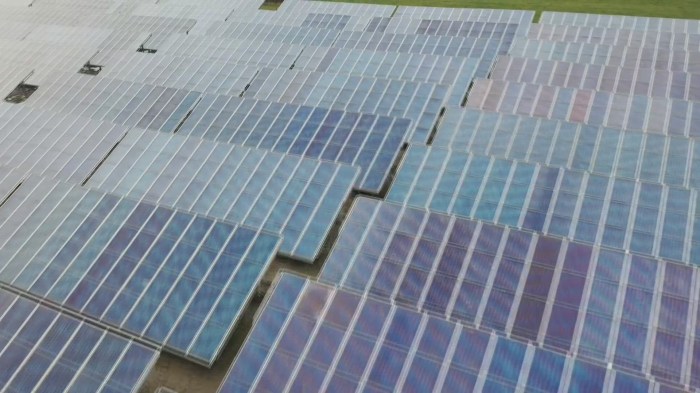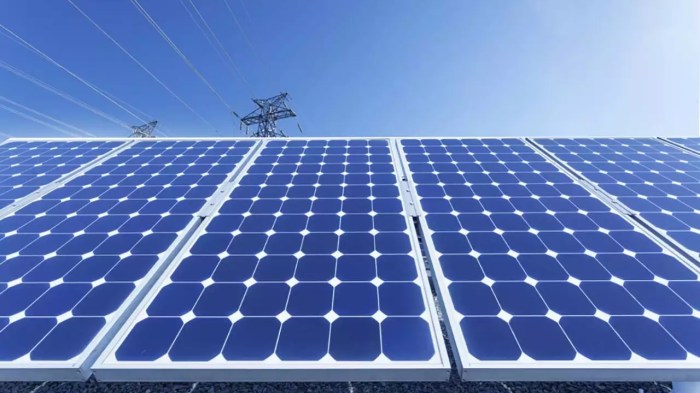Solar + EV incentives in Colorado 2025 are shaping up to be a big deal for anyone looking to go green. Think tax breaks, rebates, and maybe even some sweet deals bundling solar panel installation with an electric vehicle purchase. We’re diving into the nitty-gritty of what’s available, comparing federal and state programs, and looking at how these incentives could totally change the landscape of clean energy adoption in the Centennial State.
Get ready to electrify your future (and your wallet!).
This deep dive will cover everything from the specifics of federal tax credits and state-level rebates for solar installations to the various incentives available for buying EVs in Colorado. We’ll analyze how these programs might work together, offering potential cost savings and environmental benefits for homeowners. We’ll also explore projections for solar and EV adoption growth, and discuss the potential challenges and future outlook for these incentives.
Federal and State Solar Incentives in Colorado (2025)
Navigating the world of solar incentives can be tricky, but understanding the options available in Colorado for 2025 can significantly impact your decision to go solar. Both the federal government and the state of Colorado offer programs designed to make solar energy more accessible and affordable. This overview will clarify the specifics of these incentives.
Federal Solar Tax Credit
The federal Investment Tax Credit (ITC) remains a significant incentive for homeowners and businesses installing solar panels. For 2025, the ITC provides a tax credit equal to 30% of the cost of a new solar energy system. This credit applies to the cost of the solar panels, inverters, batteries, and installation. It’s a direct reduction of your federal income tax liability, making solar a more financially attractive option.
To claim the credit, you’ll need to file Form 5695 with your federal tax return. Keep in mind that certain conditions and limitations may apply, so consulting a tax professional is always a good idea.
Colorado State Solar Incentives
While the federal ITC is a strong incentive, Colorado also offers its own programs to support solar adoption. Unfortunately, specific details on Colorado’s state-level incentives for 2025 are still evolving and may vary depending on your utility provider and location. It’s crucial to check with your local utility company and the Colorado Public Utilities Commission (PUC) for the most up-to-date information.
Colorado’s 2025 solar and EV incentives are pretty sweet, especially with the potential for significant savings. However, before you jump in, it’s smart to check out the long-term costs, like what you might face if you need a battery replacement; check out this resource on EV battery replacement cost 2025 to get a better sense of the potential expenses.
Knowing those numbers will help you make a well-informed decision about taking advantage of those Colorado incentives.
Some potential incentives could include rebates, property tax exemptions, or other financial assistance programs. These programs often have eligibility requirements and may be subject to funding limitations, so early planning and application are advised.
Comparison of Federal and State Incentives
The federal ITC and potential Colorado state incentives are largely complementary. The federal credit applies to a wider range of solar projects, whereas state incentives might focus on specific populations or projects. There may be some overlap, but the combined effect of both federal and state incentives can significantly reduce the upfront cost of going solar. For instance, a $20,000 solar installation could receive a $6,000 federal tax credit (30%).
Adding a hypothetical $1,000 state rebate would bring the total savings to $7,000, representing a 35% reduction in cost. However, it’s crucial to note that the specific state incentives will need to be confirmed closer to 2025.
Colorado Solar Incentive Programs (2025) – Projected
It’s important to understand that the details below are projections based on current trends and may change. Always verify information directly with the relevant authorities before making any decisions.
| Program Name | Eligibility | Incentive Type | Incentive Amount |
|---|---|---|---|
| Federal Investment Tax Credit (ITC) | Homeowners and businesses installing new solar systems | Tax Credit | 30% of system cost |
| Xcel Energy Solar Rewards (Projected) | Xcel Energy customers in eligible areas | Rebate | Variable, check Xcel Energy website |
| Black Hills Energy Solar Incentive Program (Projected) | Black Hills Energy customers in eligible areas | Rebate/Bill Credit | Variable, check Black Hills Energy website |
| Potential Colorado Property Tax Exemption (Projected) | Homeowners meeting specific criteria | Property Tax Reduction | Varies by county and assessment |
EV Incentives in Colorado (2025)
Navigating the world of electric vehicle (EV) incentives can feel like driving through a minefield, but fear not! Colorado offers a variety of state and federal programs designed to make going electric more affordable. Keep in mind that incentive amounts and eligibility criteria can change, so always check with the relevant agencies for the most up-to-date information before making a purchase.
This overview provides a snapshot of what might be available in 2025, based on current trends and programs.
State and Federal EV Incentives Available in Colorado (2025)
Colorado’s EV incentive landscape is a blend of state and federal programs. The state’s programs often focus on specific vehicle types or income levels, while federal incentives are broader but subject to change depending on federal legislation and budget allocations. It’s crucial to understand both to maximize potential savings.
- Colorado Clean Vehicle Incentive Program (CVIP): This program offers rebates on the purchase or lease of new and used EVs, plug-in hybrid electric vehicles (PHEVs), and fuel cell electric vehicles (FCEVs). Eligibility typically depends on income levels and the vehicle’s battery capacity. The exact rebate amounts and income limits are subject to annual adjustments and funding availability, so checking the program’s website directly before purchase is strongly advised.
For example, in the past, the program has offered rebates ranging from a few hundred dollars to several thousand dollars, depending on the vehicle and buyer qualifications.
- Federal Tax Credit: The federal government offers a significant tax credit for the purchase of new EVs. The amount of the credit depends on the vehicle’s battery capacity and manufacturer’s suggested retail price (MSRP). However, there are limits on the number of vehicles a manufacturer can sell before the credit begins to phase out. For example, a buyer purchasing a qualifying EV could receive a tax credit of up to $7,500, but this amount can fluctuate.
This credit is claimed when filing your federal income tax return, not at the point of sale.
Eligibility Criteria for Colorado EV Incentive Programs
Eligibility for each program has specific requirements. These requirements often include factors like income limits, vehicle type, and proof of residency.
- Income Limits: Many state programs prioritize lower- and middle-income households by setting income thresholds for eligibility. These limits are adjusted periodically to reflect changes in the cost of living. For instance, a family of four might need to earn below a certain annual income to qualify for a particular rebate.
- Vehicle Type and Battery Capacity: Programs often specify eligible vehicle types (e.g., battery electric vehicles, plug-in hybrids) and may set minimum battery capacity requirements. This ensures that the incentives are targeted towards vehicles with a significant level of electrification.
- Residency Requirements: Applicants must typically be Colorado residents to be eligible for state incentives. Proof of residency, such as a driver’s license or utility bill, is usually required.
Potential Changes or Updates to Colorado’s EV Incentive Programs in 2025
Predicting changes to incentive programs is inherently difficult. However, based on current trends, we can anticipate potential modifications.
Colorado may adjust its incentive amounts or eligibility criteria based on budget availability and the overall success of its EV adoption goals. For instance, the state might increase the rebate amounts to encourage wider adoption or modify income thresholds to better target specific demographics. Federal changes to the tax credit could also influence the overall landscape of incentives available in Colorado.
It’s crucial to stay informed about any legislative updates or announcements from the Colorado Energy Office and other relevant agencies.
Application Process Flowchart for a Typical Colorado EV Incentive Program
A simplified flowchart illustrating the typical application process for a Colorado EV incentive program could look like this:
Imagine a flowchart with boxes and arrows. The first box would be “Purchase/Lease Eligible EV”. An arrow would lead to “Gather Required Documents” (proof of residency, purchase agreement, etc.). Another arrow would lead to “Complete Application Online/By Mail”. Then, an arrow would lead to “Application Review and Processing”.
Following this, an arrow would point to “Approval/Rejection Notification”. If approved, an arrow would lead to “Incentive Payment”. If rejected, an arrow would point to “Reasons for Rejection and Appeal Process (if applicable)”.
Combined Solar + EV Incentive Programs in Colorado (2025): Solar + EV Incentives In Colorado 2025

Currently, Colorado doesn’t have a single, unified program explicitly combining incentives for both solar energy and electric vehicles. However, the state offers separate, robust incentive programs for each, and it’s possible to leverage both simultaneously to achieve significant savings. The effectiveness of this combined approach depends on individual circumstances and the specific incentives available at the time of purchase and installation.
Future policy changes could also introduce more integrated programs.Existing programs offer substantial individual benefits that can be stacked. For example, a homeowner could utilize the federal tax credit for solar installations, along with Colorado’s own state incentives for solar power, and then separately claim rebates or tax credits offered through state and federal programs for the purchase of an electric vehicle.
The combined effect of these separate incentives could lead to considerable cost reductions.
Examples of Combined Incentive Application
A homeowner could receive a federal tax credit for installing solar panels on their home, reducing their initial investment. Simultaneously, they could use state rebates to further lower the cost of the solar installation. Separately, they could take advantage of the federal tax credit for electric vehicle purchases, and potentially utilize Colorado’s incentives for EV purchases, such as rebates or preferential registration fees.
These incentives, applied concurrently, significantly reduce the overall cost of both the solar installation and the electric vehicle purchase. This would make both options more financially accessible.
Potential Benefits and Drawbacks of Combined Incentive Programs
The primary benefit of combined programs would be increased adoption of both solar energy and electric vehicles. This would contribute to Colorado’s goals for renewable energy and reduced carbon emissions. However, a potential drawback is the administrative complexity. Managing multiple incentive programs could prove challenging for both homeowners and the agencies administering the programs. There is also the possibility of overlap or redundancy in incentives, potentially leading to inefficient use of public funds.
Another potential drawback is that such programs may disproportionately benefit higher-income households who are better positioned to take advantage of the incentives.
Potential Scenarios for Homeowners
The following scenarios illustrate how a homeowner might benefit from combined solar and EV incentives in 2025. These are illustrative examples and the exact amounts will depend on the specifics of available programs and the homeowner’s situation. It is crucial to check with the relevant authorities for the most up-to-date information.
- Scenario 1: High-Income Homeowner A high-income homeowner installs a $20,000 solar panel system and purchases a $50,000 electric vehicle. They receive a 30% federal tax credit for both the solar system and the EV, plus a $5,000 state rebate for the solar system and a $2,000 state rebate for the EV. The total savings could be significant, potentially exceeding $20,000.
- Scenario 2: Middle-Income Homeowner A middle-income homeowner installs a $10,000 solar panel system and purchases a $40,000 electric vehicle. They receive a 26% federal tax credit for both, a $2,000 state rebate for solar, and a $1,000 state rebate for the EV. Their combined savings could still be substantial, perhaps reaching $10,000.
- Scenario 3: Low-Income Homeowner A low-income homeowner might qualify for additional assistance programs alongside the standard incentives, potentially making both solar and an EV financially feasible. This would require research into specific programs targeted at low-income households.
Impact of Incentives on Solar Adoption and EV Sales in Colorado (2025)

The combined effect of federal and state incentives on solar energy adoption and electric vehicle (EV) sales in Colorado in 2025 is projected to be significant, boosting both sectors considerably beyond what would be expected without these support mechanisms. This synergistic effect, where incentives for one technology encourage adoption of the other (e.g., solar powering EVs), will amplify the overall positive impact on the state’s economy and environment.The projected growth in solar installations and EV sales will be driven primarily by the financial benefits offered through these incentive programs.
Reductions in upfront costs, coupled with potential long-term savings on energy bills (solar) and fuel costs (EVs), make these technologies more accessible and attractive to a wider range of consumers. Furthermore, the increased awareness and positive public perception surrounding sustainability are likely to further contribute to increased adoption rates.
Projected Growth Percentages and Economic Benefits, Solar + EV incentives in Colorado 2025
Colorado’s solar market is expected to see a substantial surge in installations due to the incentives. A reasonable projection is a 30-40% increase in new solar installations in 2025 compared to 2024. This prediction is based on similar incentive-driven growth observed in other states like California and Arizona, adjusting for Colorado’s unique market conditions. For EV sales, a 25-35% increase is anticipated, building upon the already growing popularity of EVs in the state.
This is a conservative estimate, factoring in potential supply chain limitations and overall market conditions. The economic benefits stemming from this growth will be substantial. The increased demand for solar panels and EV infrastructure will create new jobs in manufacturing, installation, and maintenance sectors. Additionally, reduced reliance on fossil fuels will translate to decreased air pollution, leading to improved public health and reduced healthcare costs.
The state can also expect a boost in tourism and attract investments from companies specializing in clean energy technologies.
Challenges and Barriers to Incentive Success
Despite the positive projections, several challenges could hinder the full realization of the incentives’ potential. One major challenge is the potential for supply chain bottlenecks, especially concerning solar panel manufacturing and EV battery production. This could limit the availability of these technologies and slow down adoption rates. Another barrier is the affordability of EVs, even with incentives, for low- and middle-income households.
Effective outreach programs and targeted financial assistance may be needed to ensure equitable access. Furthermore, the long-term effectiveness of these incentives hinges on the political landscape and potential changes in policy. Uncertainty regarding future incentive programs could discourage investment and hamper long-term growth.
Visual Representation of Projected Growth
Imagine a double bar graph. The X-axis represents the years 2024 and
So, Colorado’s 2025 solar and EV incentives are looking pretty sweet, right? I’m totally stoked about the potential savings, especially considering the buzz around Lightyear Solar EV availability in the US. If those solar-powered cars hit the market, those Colorado incentives could make going green even more affordable. It’ll be interesting to see how these incentives impact the adoption of EVs in the state.
2025. The Y-axis represents the number of installations/sales. Two sets of bars are present for each year
one for solar installations and one for EV sales. The 2025 bars for both solar and EV sales are significantly taller than their 2024 counterparts, illustrating the projected growth. The height difference for the solar installation bar would be more pronounced than that of the EV sales bar, reflecting the higher projected growth percentage for solar installations. The graph’s title would be “Projected Growth of Solar Installations and EV Sales in Colorado (2024-2025)”.
A legend would clearly identify each bar type. The graph visually demonstrates the significant positive impact of the combined incentives on both sectors, highlighting the synergistic relationship between the two.
Future Outlook of Solar and EV Incentives in Colorado
Predicting the future of solar and EV incentives in Colorado requires considering several interconnected factors. While current programs are robust, their longevity and evolution depend on economic shifts, technological progress, and evolving environmental policies. The state’s commitment to renewable energy and transportation electrification will undoubtedly shape the landscape of these incentives in the coming years.The trajectory of solar and EV incentives in Colorado beyond 2025 will likely be a blend of continuation and adaptation.
We can expect a gradual phasing out of some existing programs as technology matures and market penetration increases. However, new incentives tailored to address emerging challenges and opportunities will likely emerge.
Factors Influencing Future Incentive Policies
Several key factors will significantly influence the future of solar and EV incentives. Energy prices, especially electricity costs, play a crucial role. High electricity prices bolster the economic case for solar adoption, potentially reducing the need for extensive government subsidies. Conversely, fluctuating energy prices could necessitate adjustments to incentive levels to maintain affordability and competitiveness. Technological advancements, such as improved battery technology for EVs and more efficient solar panels, will also influence policy.
As costs decrease, the need for substantial incentives might lessen. Finally, increasingly stringent environmental regulations at both the state and federal levels will likely incentivize further adoption of cleaner energy solutions, potentially leading to extended or enhanced incentive programs. For example, stricter emission standards for vehicles could spur greater demand for EVs, necessitating continued support through tax credits or rebates.
Projected Evolution of Incentive Policies
We can anticipate a shift towards more targeted and nuanced incentive programs. Instead of broad-based rebates, future policies may focus on specific demographics (low-income households, rural communities) or technologies (energy storage systems paired with solar, electric trucks). Incentives may also become more performance-based, rewarding higher energy efficiency or longer-term commitments to renewable energy. For instance, Colorado might implement a tiered rebate system for EVs, offering higher incentives for vehicles with longer ranges or better energy efficiency ratings.
Similarly, solar incentives could be structured to reward homeowners who integrate energy storage solutions, promoting grid stability and resilience.
Timeline of Potential Changes (2025-2030)
The following timeline Artikels potential changes, acknowledging inherent uncertainty in policymaking:
| Year | Solar Incentives | EV Incentives |
|---|---|---|
| 2025-2027 | Continued existing rebates and tax credits, with potential adjustments based on market penetration and energy prices. Pilot programs for community solar initiatives might be launched. | Existing rebates and tax credits remain, with a focus on expanding charging infrastructure and incentivizing the purchase of electric trucks and buses. |
| 2028-2029 | Gradual phase-out of some existing rebates, replaced by performance-based incentives focusing on energy storage and grid integration. Increased emphasis on financing options for solar installations. | Incentives for EV purchases might shift towards lower-income households, with potential subsidies for used EVs. Increased focus on workforce development in the EV sector. |
| 2030 | Incentives primarily focused on advanced solar technologies and grid modernization. A potential shift towards tax credits linked to carbon reduction targets. | Continued support for charging infrastructure, particularly in underserved areas. Incentives may focus on specific vehicle types or technologies, such as hydrogen fuel cell vehicles. |
Final Wrap-Up

Ultimately, the combined push of federal and state incentives for solar and EVs in Colorado in 2025 presents a compelling opportunity for residents to embrace cleaner energy solutions. While challenges remain, the potential economic benefits and environmental impact are significant. By understanding the available programs and their potential synergies, Coloradans can make informed decisions that benefit both their wallets and the planet.
Let’s make Colorado a leader in sustainable living!









